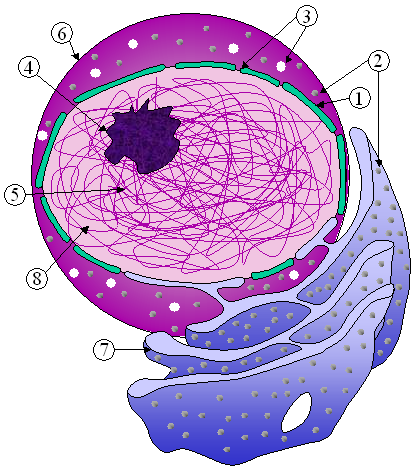Cell nucleus
|
|
In cell biology, the nucleus (from Latin nucleus or nuculeus, kernel) is an organelle, found in all eukaryotic cells, which contains most of the cell's genetic material. Nuclei have two primary functions: to control chemical reactions within the cytoplasm and to store information needed for cellular division.
The nucleus, being the largest organelle (in some cases not), varies in diameter from 10 to 20 micrometres. It is enclosed by a double membrane called the nuclear envelope. The inner and outer membrane fuse at regular intervals, forming nuclear pores. The nuclear envelope regulates and facilitates transport between the nucleus and the cytoplasm, while separating the chemical reactions taking place in cytoplasm from reactions happening within the nucleus. The outer membrane is continuous with the rough endoplasmic reticulum (RER) and may be studded with ribosomes. The space between the two membranes (called the "perinuclear space") is continuous with the lumen of the RER. The nuclear face of the nuclear envelope is surrounded by a scaffold of filaments called the nuclear lamina.

Drawing of nucleus and the endoplasmic reticulum.
(1) Nuclear envelope. (2) Ribosomes. (3) Nuclear pore complexes. (4) Nucleolus.
(5) Chromatin. (6) Nucleus. (7) Endoplasmic reticulum. (8) Nucleoplasm.
The whole structure is surrounded by cytoplasm. (Drawing is based on ER images.)
Inside the nucleus is one or several nucleoli surrounded by a matrix called the nucleoplasm. The nucleoplasm is a liquid with a gel-like consistency (similar in this respect to the cytoplasm), in which many substances are dissolved. These substances include nucleotide triphospates, enzymes, proteins, and transcription factors. There also exists a network of fibers in the nucleoplasm known as the nuclear matrix.
Genetic material (DNA) is also present in the nucleus, the DNA is present as a DNA-protein complex called chromatin. The DNA is present as a number of discrete units known as chromosomes. There are two types of chromatin: euchromatin and heterochromatin. Euchromatin is the least compact form of DNA, and the regions of DNA which constitute euchromatin contain genes which are frequently expressed by the cell.
In heterochromatin, DNA is more tightly compacted. Regions of DNA which constitute heterochromatin generally contain genes which are not expressed by the cell (this type of heterochromatin is known as facultative heterochromatin) or are regions which make up the telomeres and centromeres of the chromosomes (this type of heterochromatin is known as constitutive heterochromatin). In multicellular organisms, cells are highly specialised to perform particular functions, hence different sets of genes are required and expressed. Therefore, the regions of DNA that constitute heterochromatin vary between cell types.
Nucleoli are densely-stained structures at which ribosome subunits are assembled.
| Organelles of the cell |
|---|
| Chloroplast | Mitochondrion | Centriole | Endoplasmic reticulum | Golgi apparatus | Lysosome | Myofibril | Nucleus | Peroxisome | Ribosome | Vacuole | Vesicle |
